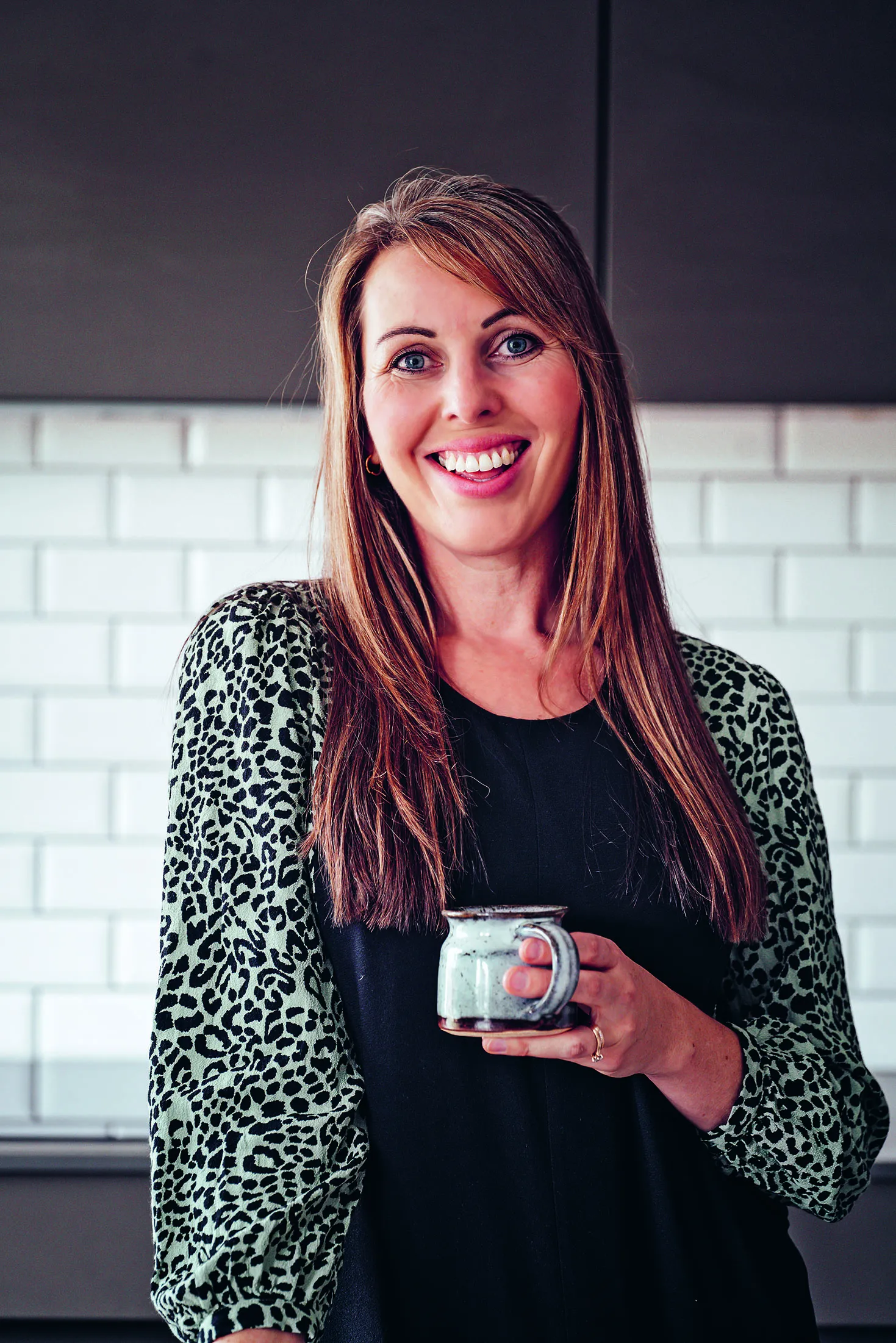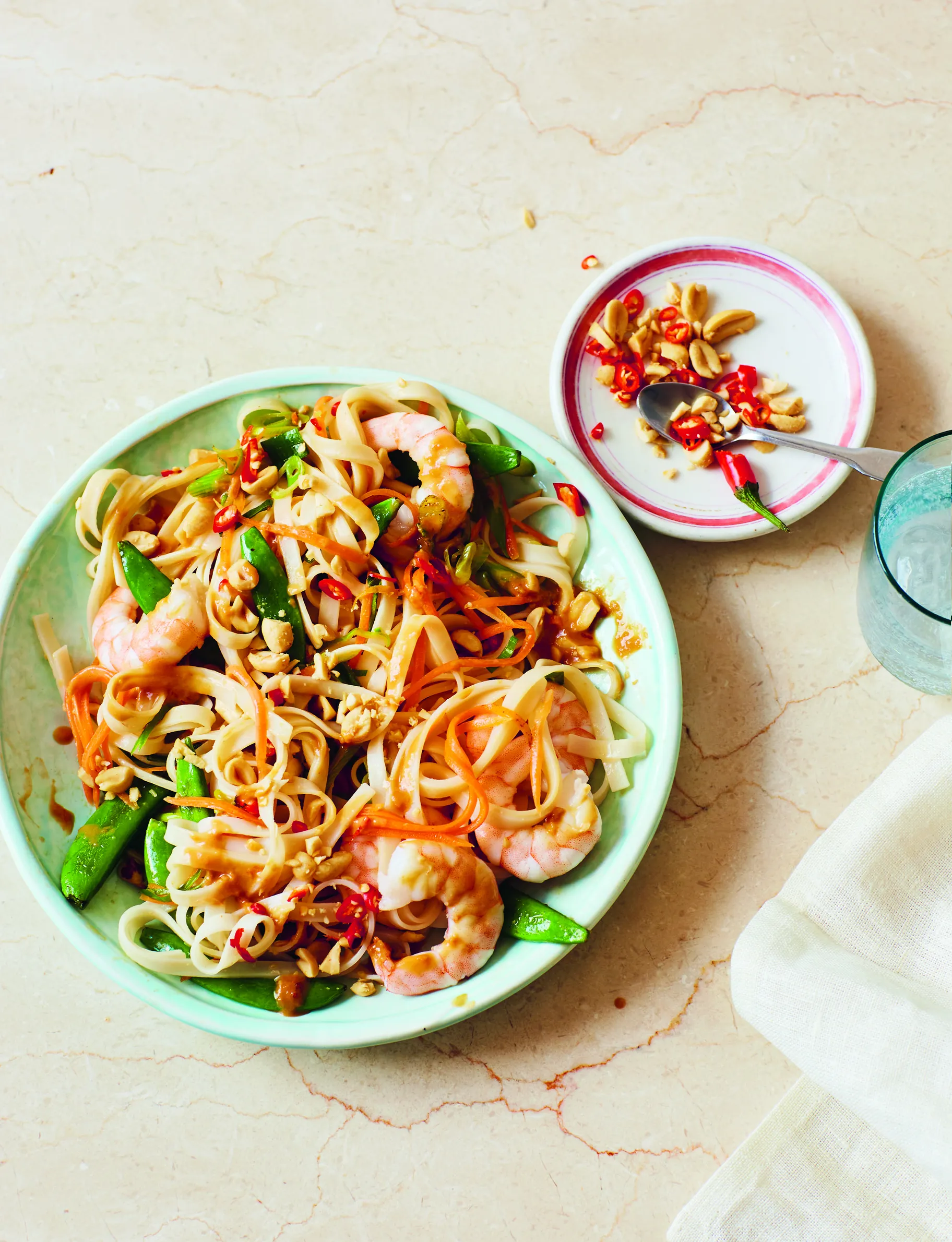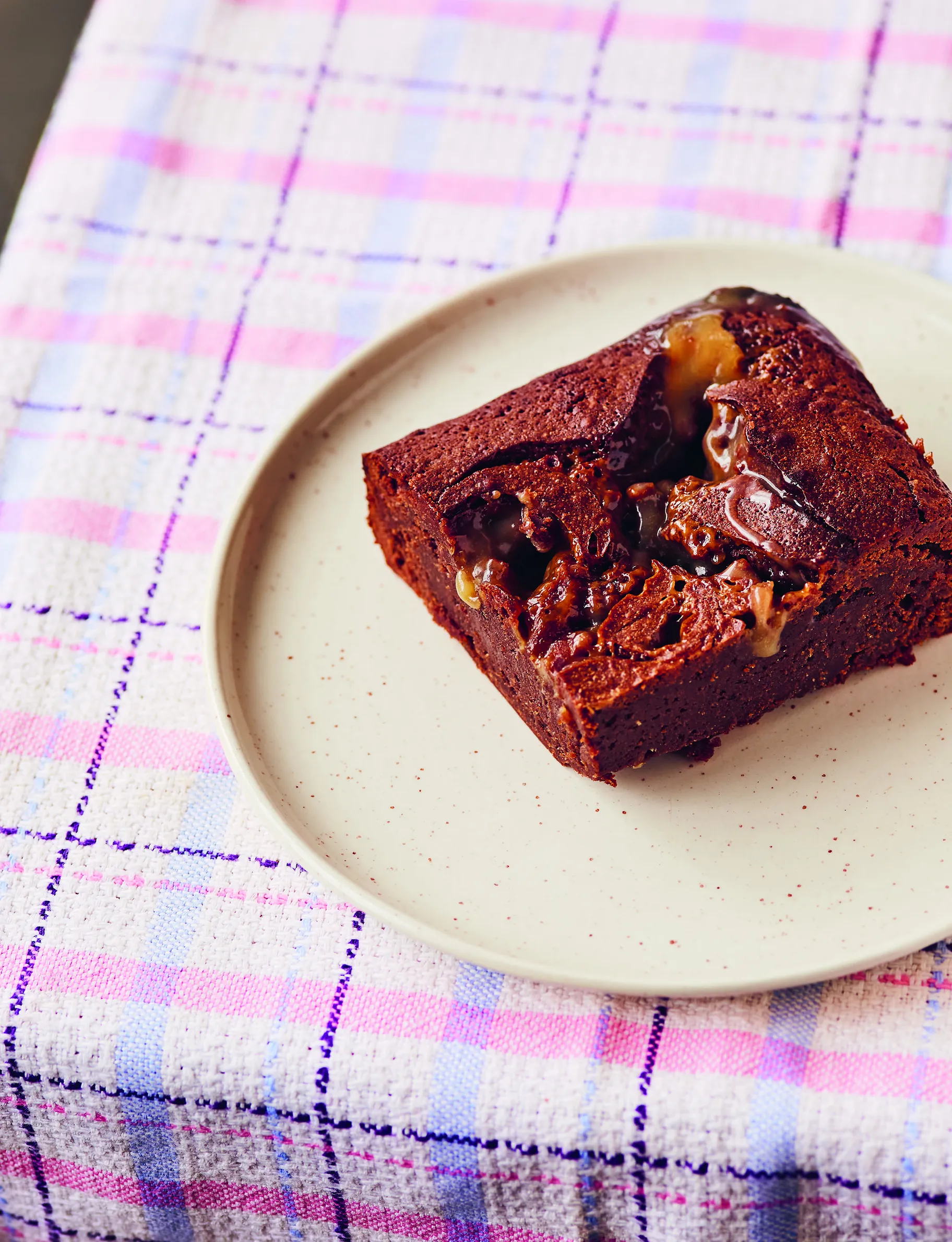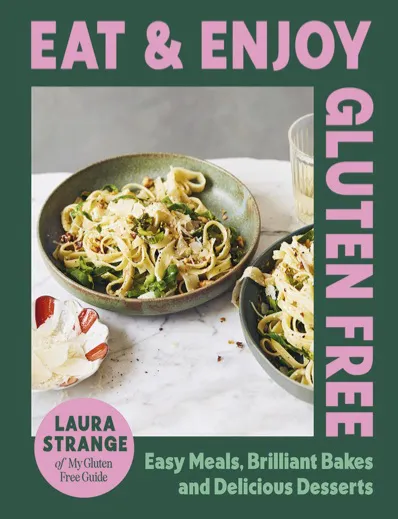Humans are programmed to want to eat food. It's how we survive. But for most of us, food is about more than survival. It's about pleasure, community, entertainment, and travel. So receiving a celiac diagnosis can be devastating. You have to learn a new culinary language, one that can often seem like a watered-down version of the foods you love. Laura Strange is here to tell us that's not the case. She's a Londoner who develops recipes and travel guides for those who need to live a gluten-free life in a gluten-centric world. Her book is Eat and Enjoy Gluten Free: Easy Meals, Brilliant Bakes and Delicious Desserts.
Evan Kleiman: How old were you when you were diagnosed with celiac disease?
Laura Strange: I was 14 when I was diagnosed with celiac disease but it must have been about age seven when I started having symptoms. Like many people, unfortunately, it took quite a while for me to get that diagnosis. In the meantime, I got so poorly, I lost a huge amount of weight, I really struggled to get through the day. Especially when you're a child and you're at school, lots of energy is needed and you really don't have that when you're an undiagnosed celiac. Then, one day, we happened to see a different doctor and she immediately recognized my symptoms as being very typical of celiac disease, got me diagnosed, and it was like a whole new lease on life. While having celiac disease can be so hard to live with, for me, getting that diagnosis was one of the best things that has ever happened to me because it enabled me to then get healthy and strong and really live a wonderful life again.

Diagnosed 25 years ago with celiac disease, Laura Strange develops gluten-free recipes and travel guides. Photo by Kristie Young.
At the time of your diagnosis, you were still living at home, and I imagine that your meals were still being planned and prepared by a parent, so you had to embark on this new world as a family. Did you have a memorable set of disaster substitutions that made you despair for your situation?
Absolutely. I remember you couldn't get gluten-free products so readily then. This was 25 years ago. Now, there's a really good availability of gluten-free products but back then, they were hard to source. Some, you had to get from pharmacists, some from the back shelf of health food shops.
I remember we bought some vegetable pasta and, as you are busy at home, we hadn't quite observed the cooking instructions, so we cooked the pasta for a little bit too long. I went to the saucepan to stir the pasta and it had disappeared. All that was left was a sludge at the bottom of the pan because [the pasta was] vegetable-based. It had completely disintegrated. That was very memorable.
And the early gluten-free bread, some of it was atrocious. It would either crumble apart like sand or be so brick-like that there was a risk you could knock someone out if you threw it. I would not recommend doing that.
Many people think that the biggest challenge of cooking gluten-free meals are those that focus on breads, cakes, cookies, pies, noodles, and foods that are enrobed in batters, UK staples like fish and chips. You've been cooking this way for a long time. Has your approach to creating recipes changed due to the evolution of ingredients that are available?
Absolutely. There's such a wonderful, wide range of gluten-free ingredients now. There's a better understanding of gluten-free products, as well, by some chefs. For example, some professionals now make their fish and chips with gluten-free flour as standard because it happens to make a better batter. That's really encouraging to see some recognition of gluten-free foods as not always being second class or subpar.
I imagine that you must spend a lot of time educating other people about what you can and can't eat. What do people misunderstand about celiac?
I think there are quite a few common misconceptions. Celiac disease, it's not an allergy, it's an autoimmune condition, a genetic condition that can run in families. My mother also has celiac disease. Unfortunately, once you have it, you cannot grow out of it, you are celiac for life. You have to stick to a really strict gluten-free diet.
While there's lots of gluten-free food options available, sometimes they might not be safe for celiacs because of cross-contact. Cross-contact occurs when a gluten containing food item touches your gluten-free one, making it no longer safe for celiacs. That's not always widely known. If you're preparing food for celiacs, you have to be really mindful of how you're preparing things, be really hygienic and safe about how you're cooking because even the smallest amount of gluten can make celiacs really poorly.
Why does wheat-free not necessarily mean gluten-free?
That's a great question. You find gluten not just in wheat but also in barley and rye and oats unless they are specially milled as safely gluten-free. While oats contain a protein called avenin, which is similar to gluten, they are gluten-free until the milling process. They're often processed in the same location as wheat, barley and rye, hence the issue of cross-contamination. So if you are looking for gluten-free products, you need to make sure that there's no wheat, barley, rye or oats on the labels.

These 15-minute gluten-free tahini peanut butter noodles are Laura Strange's go-to weeknight recipe. Photo by Lizzie Mayson.
You say in the beginning part of the book that a first step is to embrace naturally gluten-free foods. Give us some examples.
There are so many naturally gluten-free foods that people will be eating all the time, staples such as rice, potatoes, vegetables, and meat. There are so many different gluten-free foods that you can easily incorporate into a diet and it can make it more economical to be shopping outside of your dedicated gluten-free food section. The meals also become ones that you can share with the entire family. If you're making a rice-based dish like a paella or a jambalaya, that's something you can share as a household rather than having to prepare multiple different meals.
There are magic ingredients on which you rely. Tell us about some of them.
Xanthan gum is one. It's a binder that works fantastically in cakes, pasta and pastry. You only use it in tiny quantities. When you're taking gluten out of a recipe, you're losing that binding quality that the gluten protein gives, so by introducing another binder, such as xanthan gum, you're able to ensure that you don't have a crumbly, dry cake but a lovely, fluffy sponge instead.
Another favorite of mine is psyllium husk, which is a naturally derived seed husk. This is just incredible for making gluten-free breads. It gives you a bread dough that holds a high hydration and you can subsequently shape it and knead it, make beautiful bakes like cinnamon buns and sourdough balls and have a wonderful baking time in the kitchen.
The third one I'd love to mention is tapioca starch, which is a naturally gluten-free starch that is derived from cassava. Adding that into breads brings a stretchy property and it makes a lovely addition to pizza bases and lots of the breads that are featured in my book.
What is your easiest bread recipe of any kind from your new book? It can be a flatbread.
That's exactly the one I was thinking of. I've got a whole chapter on bread in the book. The first one in the chapter is a really easy flatbread recipe, which is one we also make a lot at home. It's made using all-purpose, gluten-free flour, baking powder, and yogurt. You can make it in 15 minutes. It's ideal when you need a bread side dish to go with dinner and you just want to whip something up. You haven't got time to run to the grocery store. You haven't got time to make yeasted bread. This flatbread is a great one to go to. It's also a wonderful place to start if you're wanting to get your confidence with baking gluten-free bread. That's something I've really done throughout my cookbook with all the chapters, starting with nice easy recipes to ease everyone into gluten-free baking or cooking and then building up your skill level as you work your way through each chapter. You can become an expert before you know it.

Laura Strange says these gluten-free brownies are her most requested bake. She even made them for her wedding. Photo by Lizzie Mayson.
Here at KCRW, Good Food hosts an annual pie contest that last year drew 500 pies and 10,000 people to the event, so pie dough is a particular obsession. How do you deal with coming from a pie-eating and pie-making culture? Is it possible to make the famed British hot water dough gluten-free? Or did you have to go in another direction?
I hadn't actually tackled the hot water dough that would often be used for making British pork pies and similar. I have to add that to my "to do" list. But I do have a beautiful shortcrust pastry in the book, which is really versatile and can be used for sweet and savory bakes. I've got a lovely chicken and wild garlic pie recipe in the book.
On the sweeter side, we've got a passion fruit meringue pie. It's a real tried and tested recipe that was on my website long before I added it to the book. I have had so much lovely feedback from people over the years who had thought, I can't make gluten-free pastry, it's gonna turn out horribly. Then they try this recipe, find it nice and end up with a beautiful pie crust. It really opens a whole new world of baking to you. Hopefully, it would fare well in your pie competition.
I'm sure it would. You said that you were particularly proud of cracking the code to egg noodles. Tell us about that.
Yes, that was a lovely one. It wasn't as hard as I thought it would be. I think the beauty of sitting down to write a gluten-free cookbook, I decided, these are all the foods that I miss having, I want to tackle all these recipes. The egg noodle recipe that I came to, they're just wonderful. My husband can eat gluten as can my children, so they're really good taste testers. When I create a new recipe and when I developed the egg noodles, my husband was blown away. He said he could not tell the difference between the classic wheat egg noodles and the gluten free ones that I've created in the book. They hold together beautifully. They can be stir fried in a chow mein or other stir fry dishes. I think being able to create a noodle that behaves as you would like it to in traditional dishes is a lovely achievement.
What is your "I'm so exhausted but I still have to make something for dinner" dish?
I have a long-term favorite and it's in the book. It's a 15-minute peanut butter tahini noodles dish. It's properly 15 minutes from start to it being on your plate. It's really versatile and family-friendly. My whole family will happily eat it. The base dish is vegan, then you can add in the protein of your choice, whether it's tofu or you want to add chicken or prawns or keep it simple. I think we all need one of those in our repertoire when we have had a busy day at work and need to feed the family and you just want to sit down but you also want to have a good plate full of food. That is my go-to recipe.
What is your most requested sweet bake from friends and family?
There's a clear winner here. I have a salted caramel brownie recipe in the cookbook. It has almost become an accidental signature bake with my friends and family. My friends are always requesting that I bring the brownies with me and I'm always glad to because they're really easy, I can make them the night before, they just happily sit however long. I rate these brownies so much that when I got married eight years ago, I actually made my wedding cake out of them. My bridesmaids and I made this gigantic tower of gluten-free brownies because we could bake them a couple of days before and decorate them very beautifully. I didn't tell anyone that it was all gluten-free. The best thing was that by the end of the wedding, all the brownies had been eaten. There were literally only crumbs remaining. It was really nice seeing everyone enjoy something that I knew was gluten-free.
I love that. You also have extensive travel guides on your website. In terms of eating out, how much do you worry about eating in an establishment that has some gluten-free options but isn't 100% gluten free?
That's such a good point to mention. It's really hard, getting over that worry and anxiety about eating out. A lot of it comes down to confidence and experience. For newly diagnosed celiacs, it can be really terrifying and I think, ultimately, anytime you're eating out, you're having to put trust in strangers, essentially, to prepare your food safely. The way I go about it is I always do research before eating out. That way, I've always got some restaurants on my radar that I want to try. It helps me with my confidence, as well, knowing okay, I've read reviews about this place, they've catered for celiacs before, it seems like a good bet.
When I get there, I'm always polite and clear and confident and ask questions about how things are prepared. I manage to eat out regularly and I have not been glutened by a restaurant for a long, long time. I think having the confidence to walk away — and you can do it politely, always, of course — but having the confidence to walk away if you don't think they can cook you safely is an important skill. Asking things like, "Are the fryers used to cook gluten or are they a dedicated gluten-free fryer?" "Can you make an effort to avoid cross-contact while preparing my food?" Questions like that will reassure you and, hopefully, lead to a really positive eating experience.

"Eat and Enjoy Gluten Free" by Laura Grant features tons of tasty recipes. Photo courtesy of Hardie Grant.
When I was going through your travel recommendations, and I clicked on my city, Los Angeles, I was so dismayed to see that it was the worst offender when it came to cross-contamination.
I think the last time I visited LA, it was the peak of gluten-free being a big trend. While gluten-free was really widely available in the restaurants that we went to eat at, I remember seeing one place that was recommended, and I went there, they were like, "Oh, you're celiac? No, you can't eat anything here. Everything's prepared on the same grill." But that said, we did find some incredible gluten-free food. I am sure, these days, it's a much more celiac friendly city. I'll have to visit again soon and find out.
I'm curious how you feel watching this rise of a gluten-free lifestyle in people who are not celiac but who perceive gluten-free products as generally healthier.
I think it's all personal choice. There are so many different medical conditions that require or benefit from a gluten-free diet, not just celiac disease, conditions like IBD, IBS, endometriosis, many of those people find it alleviates the symptoms to be gluten-free. Then, of course, there's also lots of people who just feel better for eating a gluten-free diet. It comes down to individual choice, doesn't it? We know what works best for our bodies. If we feel that gluten-free makes us feel better, then what's to stop everyone from having that diet? I think it's important to remember that it's not only celiacs who need to be gluten-free sometimes.
15-Minute Peanut Butter Tahini Noodles
Serves 2
These noodles are my ultimate go-to dinner when I want a satisfying bowlful but can’t be bothered to do much cooking. Quick and easy to make, yet filling and wonderful to eat.
Ingredients
- 180 g (6 oz) flat rice noodles or rice sticks
- 2 tablespoons gluten-free tamari
- juice of 1 lime
- 2 tablespoons smooth peanut butter
- 1 tablespoon tahini
- 1 tablespoon sweet chilli sauce
- 1 tablespoon sesame oil
- 150 g (5 1/2 oz) sugar snap peas
- 3 spring onions (scallions), sliced into rounds
- 1 large carrot, thinly sliced into long strips
Instructions
-
First, pre-cook the noodles/rice sticks. Bring a large saucepan of water to the boil, add the noodles and cook them in simmering water for 5 minutes, or until they are soft but still have some bite to them.
-
Drain, rinse under cold, running water, then transfer them to a saucepan of COLD water – this will stop the noodles from getting stuck together. Set them aside (in the water) until needed.
-
Mix the tamari, lime juice, peanut butter, tahini and sweet chilli sauce together in a small bowl until you have a smooth paste. If it’s quite thick, add 1–2 teaspoons water to thin the sauce. Set aside.
-
Add the sesame oil to a wok and place over a high heat, before adding the sugar snap peas, spring onions and carrot. Stir the ingredients around for a few minutes (still over a high heat) until the sugar snaps have turned a vibrant green.
-
Drain the noodles and add them to the wok, pouring the peanut butter tahini sauce over the top. Stir well to ensure everything is coated in the sauce and toss in the wok for a minute.
-
Serve the noodles in two bowls, topped with any combination (or all) of sesame seeds, crushed peanuts, sliced spring onions and chilli flakes. Delish!
Salted Caramel Swirl Brownies
Serves 12
My friends and family adore these brownies and they are my most requested bake from them. The base is a wonderfully fudgy chocolate brownie, swirled with an easy homemade salted caramel sauce. The resulting brownies are utterly scoffable!
Ingredients
- 250 g (9 oz) salted butter
- 125 g (4.5 oz) dark chocolate with at least 70% cocoa solids, chopped into small pieces
- 125 g (4.5 oz) milk chocolate, chopped into small pieces
- 4 eggs
- 230 g (8 oz) golden caster (superfine) sugar
- 1 teaspoon vanilla bean paste or vanilla extract
- 150 g (5.5 oz) gluten-free plain (all-purpose) flour
For The Salted Caramel Sauce
- 40 g (1.5 oz) salted butter
- 30 g (1 oz) light brown sugar
- 20 g (0.75 oz) caster (superfine) sugar
- 25 g (1 oz) golden (light corn) syrup
- 65 ml (2.25 fl oz) double (heavy) cream
- 1⁄2 teaspoon sea salt flakes
Instructions
-
Start by making the salted caramel. Melt the butter, both sugars and the golden syrup together in a small non-stick saucepan over a low heat and cook very gently for 10 minutes, or until it is starting to bubble and simmer slightly. Swirl the pan to mix the ingredients.
-
Add the cream and salt to the pan, swirling (but not stirring) to ensure that the ingredients are fully mixed, then cook for another minute over a low heat to warm the cream. Remove from the heat and leave to cool.
-
Now for the brownies. Grease and line a 24 cm (91⁄2 in) square brownie tin (pan) with baking parchment. Melt the butter and chocolate together in a non-stick saucepan over a low heat. Keep the heat low and stir occasionally until you have a lovely glossy pan of molten chocolate. Remove from the heat and leave to cool slightly. Preheat the oven to 180°C fan (400°F).
-
Add the eggs, sugar and vanilla to a large bowl and beat with a wooden spoon until they are well combined.
-
Once the chocolate mix has cooled a little (it should still be warm, but you should be able to put your little finger into it without it burning you), pour the chocolate mix into the egg and sugar bowl, stirring quite vigorously as you pour. It is important that the chocolate mix is not hot (just warm) when you pour it, otherwise you risk cooking the eggs. Both mixes should be completely combined now.
-
Sift the flour over the top of the chocolate mix and fold it in as you go. Stir well until all the flour is fully combined and there are no lumps remaining. Pour the brownie mix into the prepared cake tin. It should level itself out but give it a shake to get it to the corners if needed.
-
Next, dollop 9 teaspoons of the salted caramel sauce over the top of the brownie mix, then use a knife or skewer to gently swirl the caramel across the top of the brownies to create a pattern.
-
Bake for 25 minutes for lovely squidgy salted caramel brownies. They will have a slight wobble to them, but you will see the top has begun to crack around the edges and the caramel has hardened. If the mix is still quite sloppy, pop them back into the oven for another 5–10 minutes. I like these salted caramel brownies to be dense and fudgy. If you prefer cakey brownies, you should cook them for 35–40 minutes.
-
While the salted caramel brownie is cooling in the tin, spoon another 9 teaspoons of salted caramel sauce into the cracks and swirls to boost the salted caramel factor. Leave the brownies to cool completely, then firm them up in the refrigerator for at least 1 hour, or overnight. Lift the brownie out of the tin and cut into chunks. YUM. These brownies can be stored in an airtight container in the refrigerator for up to five days.
